The BALTIC SEA ACTION PLAN updated
Initially adopted by HELCOM in 2007, the Baltic Sea Action Plan BSAP is a strategic programme of measures for a healthy Baltic Sea. The BSAP has been recently updated. Below are the actions aimed at restoring a healthy Baltic ecosystem.
The original BSAP had set 2021 as the target year for achieving good ecological status of the Baltic Sea. However, the results of the State of the Baltic Sea report, covering the years from 2011 to 2016, indicated already in 2018 that this target would not be met. We read in the preamble to the updated BSAP that the updated BSAP is based on the original BSAP and maintains the same level of ambition. It also retains all actions previously agreed on that are still to be implemented and includes, in addition, new actions to strengthen the existing efforts and tackle emerging concerns.
The updated BSAP is divided into four segments with specific goals:
- Biodiversity, with its goal of a “Baltic Sea ecosystem is healthy and resilient”,
- Eutrophication, with its goal of a “Baltic Sea unaffected by eutrophication”
- Hazardous substances and litter, with its goal of a “Baltic Sea unaffected by hazardous substances and litter”
- Sea-based activities, with its goal of “Environmentally sustainable sea-based activities”.
Each of the four segments is structured around the updated HELCOM ecological and management objectives and contains concrete measures and actions to be implemented by 2030 at the latest. General objectives were set for each segments, divided into specific actions. In addition, there is a section on horizontal topics addressing cross-cutting issues including climate change, monitoring, maritime spatial planning, economic and social analysis, knowledge exchange and awareness raising and financing.
Measures within all segments are designed to strengthen the overall resilience of the Baltic Sea, consequently improving its ability to respond to the effects of climate change.
The implementation of the actions in the updated BSAP will be tracked through the HELCOM Explorer online tool. The first reporting on the implementation of actions will take place in 2025 and the second reporting in 2029.
BIODIVERSITY
Biodiversity in the Baltic Sea is deteriorating as a result of pressures from various human activities and climate change. The BSAP states that many species and habitats are in urgent need of protection, and enhanced conservation actions are necessary alongside the reduction of pressures.
The desired biodiversity of the Baltic is described through ecological objectives of attaining:
- Viable populations of all native species;
- Natural distribution, occurrence and quality of habitats and associated communities;
- Functional, healthy and resilient food webs.
In order to reach the desired state, the following management objectives have been identified for biodiversity:
- Effectively managed and ecologically coherent network of marine protected areas;
- Minimize disturbance of species, their habitats and migration routes from human activities;
- Human induced mortality, including hunting, fishing, and incidental by-catch, does not threaten the viability of marine life;
- Effective and coordinated conservation plans and measures for threatened species, habitats, biotopes, and biotope complexes;
- Reduce or prevent human pressures that lead to imbalance in the food web.
The BSAP includes detailed descriptions of all actions recommended by HELCOM.
The BSAC also includes an important measure aimed at protecting the biodiversity in the Baltic such as the periodic review of the measures, as well as the review of the HELCOM guidance on planning and designating HELCOM marine protected areas (MPAs) by 2025 and then every 10 years.
EUTROPHICATION
The BSAP describes the current state of the Baltic in terms of specific problems.
Eutrophication remains the major environmental threat to the Baltic. It results in intense algal growth and depletion of oxygen on the bottom of the sea, further leading to vast areas with anoxic or hypoxic conditions in the Baltic Sea.
Despite a slight long-term improvement, over 96% of the region is still below good status with regard to eutrophication, including all of the open sea area and 86% of coastal waters, as shown by a HELCOM assessment for the years 2011-2016.
Eutrophication is caused by an excessive input of nutrients - phosphorus and nitrogen - to the aquatic environment. The input of nutrients to the Baltic Sea originates from natural sources and from various human activities on land and at sea, with nutrients reaching the sea via water and air.
Excessive anthropogenic nutrient inputs to the Baltic Sea in the past have led to the accumulation of a considerable amount of phosphorus in the bottom sediments. Under hypoxic conditions, or low oxygen levels, phosphate is released from the sediments, thus increasing the total nutrient load on the marine ecosystem and further fuelling the vicious circle of eutrophication in the Baltic Sea.
Inputs of nutrients to almost all sub-basins of the Baltic Sea have significantly decreased, with substantial reductions of 12 percent for nitrogen and 26 percent for phosphorus having been achieved by all HELCOM Contracting Parties over the past two decades. Nevertheless, the original targets for nutrient inputs as set by the initial Baltic Sea Action Plan (BSAP) adopted in 2007 were not achieved by 2021.
The desired state of the Baltic Sea regarding eutrophication is described by the ecological objectives:
- Concentrations of nutrients close to natural levels,
- Clear waters,
- Natural level of algal blooms,
- Natural distribution and occurrence of plants and animals,
- Natural oxygen levels.
The achievement of regional nutrient input targets – Maximum Allowable Inputs (MAI) and Nutrient Input Ceilings (NIC) – for all sub-basins, as identified in this BSAP, is the key prerequisite for achieving the ecological objectives.
HAZARDOUS SUBSTANCES AND LITTER
As shown in the BSAP, organic contaminants and radioactive substances, the Baltic Sea remains heavily impacted by hazardous substances. In particular, levels of polybrominated diphenyl ethers (PBDEs), mercury and cesium-137 are still high in all parts of the sea, and contaminants of emerging concern, such as some pharmaceuticals, were also found in almost all components of the marine environment.
Nonetheless, due to scarcity of data on contaminants of emerging concern and other indicator substances it is currently not possible to obtain a comprehensive picture of the extent of the contamination of the Baltic Sea. The BSAP draws attention to the fact that hazardous substances come from a wide range of human activities on land, such as households, sewage systems, urban storm water, agriculture, fuels, transport as well as offshore sources of pollution - the leaching of chemicals from antifouling paints, discharge of polluted water from ships, aquaculture and offshore installations, as well as accidental or intentional spills of oil or other harmful substances, dumped munition.
So far, marine litter is only assessed descriptively at the Baltic Sea scale, and monitoring of marine litter is currently under development. Data series regarding beach litter already allow for the establishment of a baseline conclusions. Most of the litter items found on beaches consist of plastics, with most of them being single-use items and linked to eating, drinking, smoking, or industrial packaging. The BSAP draws attention to the fact that derelict fishing gears (the so-called ghost nets) constitute a severe threat to marine life.
The desired state of the Baltic Sea regarding hazardous substances is described by the ecological objectives:
- Marine life is healthy;
- Concentrations of hazardous substances are close to natural levels;
- All sea food is safe to eat;
- Minimal risk to humans and the environment from radioactivity.
The BSAP’s goals and objectives for hazardous substances will be achieved when chemicals occurring in the marine environment due to human activities do not cause any dysfunction of the marine ecosystem. The desired state of the Baltic Sea, or good environmental status, also requires that the occurrence of hazardous substances does not jeopardize the functioning of ecosystem services and does not pose any risk to human health.
The desired state of the Baltic Sea with regard to marine litter is described by the ecological objective of “no harm to marine life from litter”. As for hazardous substances, achieving the goals and objective for marine litter implies that litter items, including microlitter, occur in the marine environment only in amounts that do not cause dysfunction of the ecosystem, enter food chains or physically damage marine organisms. It also means that marine litter does not adversely affect functionality of marine ecosystem services and does not pose a risk to human activities.
SEA-BASED ACTIVITIES
Sea-based activities include all human operations and constructions at sea, from commercial shipping and recreational boating to fisheries, and from construction work and dredging to energy production and the extraction of minerals, oil and gas.
This segment also includes the risks posed by underwater constructions, such as dumped munition and wrecks containing fuel. Activities at the sea bottom cause potential spills of hazardous substances and may adversely affect the marine environment and the sea-based activities.
The desired state of the Baltic Sea regarding sustainable and safe sea-based activities is described by the ecological objectives:
- No or minimal disturbance to biodiversity and the ecosystem
- Activities affecting seabed habitats do not threaten the viability of species’ populations and communities
- No or minimal harm to marine life from man-made noise.
We are very happy that wrecks and hazardous substances are included in this segment (action S34).
S34 Develop Best Environmental Practice (BEP) for comprehensive risk assessment of munitions, wrecks and hazardous submerged objects by 2025 and implement the Best Available Techniques (BAT) for environmentally sound and safe management by 2028.
HORIZONTAL TOPICS
The topics included in this section are by their nature cross-cutting, or “horizontal”, thus potentially affecting the implementation of all elements of the Baltic Sea Action Plan (BSAP) as a whole. The topics under the updated BSAP which have been identified as cross-cutting are:
- Climate change
- Monitoring
- Maritime spatial planning (MSP)
- Economic and social analysis
- Hot spots
- Knowledge exchange and awareness raising
- Financing
For more information please refer to the document at HELCOM website: Baltic-Sea-Action-Plan-2021-update.pdf (helcom.fi)






